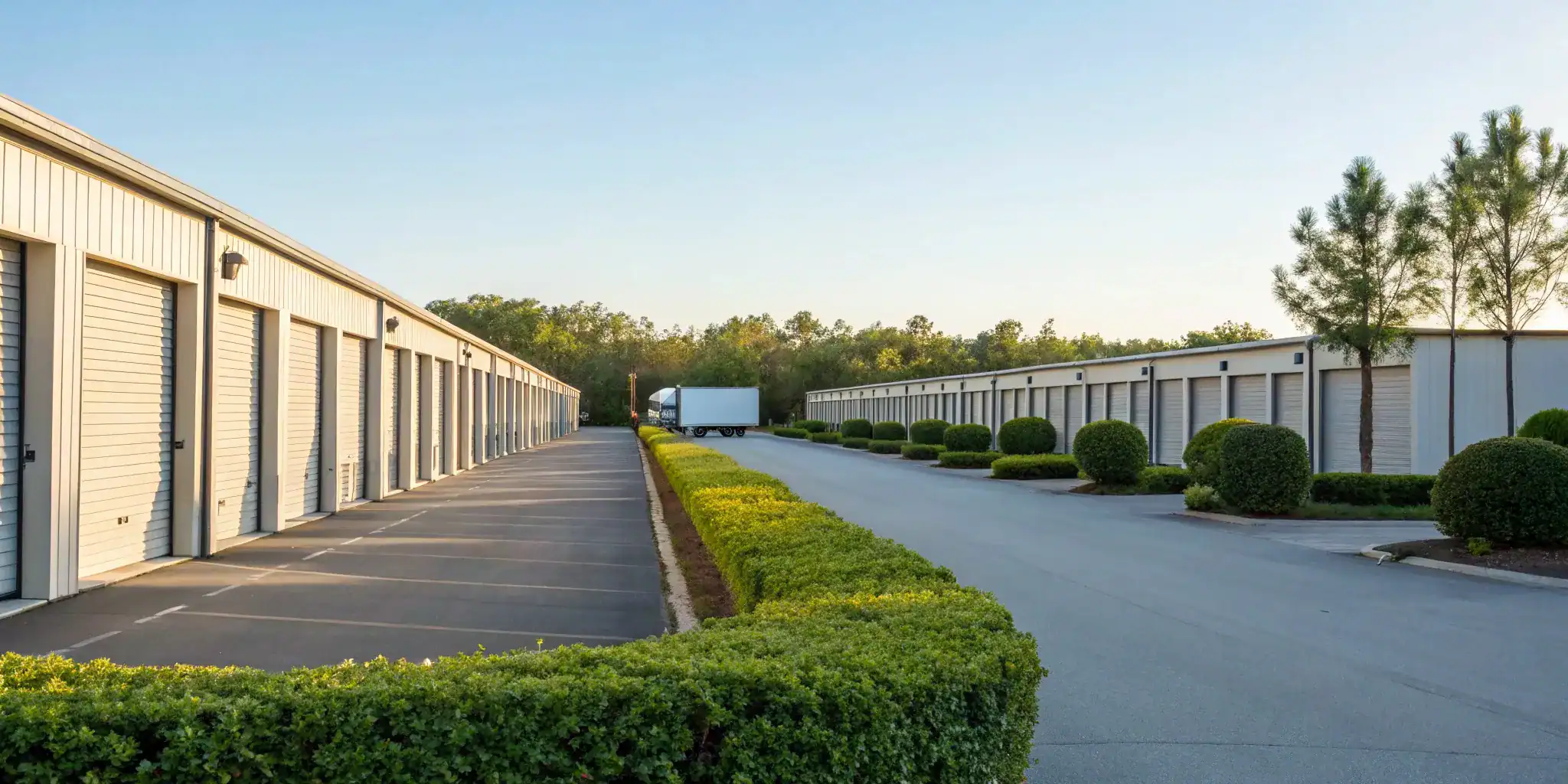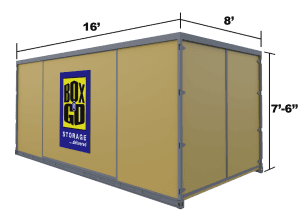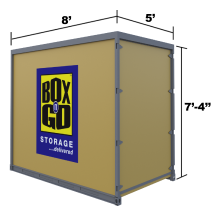Climate Control Self Storage: A Complete Guide

Let’s be honest—moving and storing your belongings can be a stressful process. The last thing you need is the nagging worry that your cherished items are slowly being ruined by intense heat or freezing cold. A standard storage unit offers basic protection, but it can’t stop the humidity that causes mildew or the temperature swings that crack wooden furniture. This is where climate control self storage makes all the difference. By maintaining a consistent, moderate environment year-round, it offers true peace of mind. It’s the definitive solution for protecting sensitive items, from electronics and artwork to important documents and delicate fabrics.
- Save 50% on move-in
- No truck rental
- Ground level










- Save 50% on move-in
- No truck rental
- Ground level
Box-n-Go Portable Storage Unit Sizes

Key Takeaways
- Protect Sensitive Items with Climate Control: This feature is more than a luxury; it’s a necessity for items like wood furniture, electronics, artwork, and documents. It maintains a stable temperature and humidity, preventing costly damage like warping, mold, and corrosion that standard units can’t stop.
- Look Beyond Price When Choosing a Company: While your inventory determines if you need climate control, the right company is defined by security, access, and convenience. Consider features like portable container delivery, 24/7 surveillance, and clear policies to ensure a stress-free experience.
- Pack Smarter for Easy Access Later: A little strategy upfront saves major headaches. Create an inventory, label boxes on multiple sides, and use vertical space with shelving. Always leave a clear walkway down the middle so you can reach items in the back without unpacking the entire unit.

What Exactly Is Climate-Controlled Storage?
If you’ve ever searched for a storage unit, you’ve probably seen the term “climate-controlled” pop up. But what does it actually mean? Simply put, a climate-controlled storage unit is an indoor space where the temperature is regulated all year long. Think of it less like a garage and more like an extra room in your home. These facilities use heating and air conditioning systems to keep the environment stable, preventing your belongings from being exposed to extreme heat, cold, or humidity.
This feature is a game-changer if you’re storing items that are sensitive to environmental changes. Things like wooden furniture, electronics, artwork, and important documents can be easily damaged by fluctuating temperatures and moisture in the air. While a standard storage unit might be fine for your patio furniture or seasonal gear, a climate-controlled space offers an essential layer of protection for your more delicate or valuable possessions. It’s about giving you peace of mind, knowing your items are kept in a consistent, safe environment, no matter what the weather is doing outside.
How Climate Control Works
So, how does a facility maintain that perfect environment? True climate control involves more than just placing a fan in a hallway. It’s a comprehensive system that uses both commercial-grade heating and air conditioning to manage the temperature inside the entire storage building. This means that whether it’s a scorching summer day or a freezing winter night, the air surrounding your unit stays within a set range. This system runs continuously to circulate the air, which not only regulates the temperature but also helps control humidity levels. It’s a proactive approach to preservation, designed to create a stable atmosphere that protects your belongings from the kind of damage that can happen in a typical, non-regulated storage space.
Store on your driveway or inside our secure facility. Load/unload only once. Ground level access.
Controlling Temperature and Humidity
The main goal of climate control is to maintain a consistent environment. Most climate-controlled facilities aim to keep the temperature between 55 and 80 degrees Fahrenheit. This moderate range is key to preventing damage caused by extreme temperature swings. For example, intense heat can cause wood to warp and electronics to malfunction, while freezing temperatures can make plastics brittle and damage sensitive items. Just as important is humidity control. High humidity can lead to mold, mildew, rust, and corrosion, while very dry air can cause wood to crack and paper to become brittle. By keeping the air from getting too damp or too dry, a climate-controlled unit helps preserve the condition of your belongings, from your antique dresser to your collection of family photos.

Climate-Controlled vs. Standard Units: What’s the Difference?
The biggest difference between a climate-controlled unit and a standard one comes down to location and environment. Standard units are often the drive-up type you see in rows, with roll-up metal doors. They are essentially garages that protect your items from rain and snow but do little to shield them from temperature and humidity changes. A
Busting Common Climate-Control Myths
Let’s clear up a few common misconceptions about climate-controlled storage. One popular myth is that it’s only necessary if you’re storing things for years. While it’s definitely a smart choice for long-term storage, it’s also crucial for protecting sensitive items even for a short period, especially if you live in an area with dramatic weather changes. Another myth is that only high-value items like fine art or antiques need this level of care. In reality, many everyday items can be damaged by extreme temperatures and humidity. This includes things like electronics, wooden or leather furniture, photographs, important documents, and even clothing. If an item could be damaged by being left in a hot or cold garage for a few months, it’s a good candidate for a climate-controlled unit.
Do Your Belongings Need Climate Control?
Deciding whether you need a climate-controlled storage unit can feel like a big question, but it really comes down to what you’re storing. While your patio furniture or holiday decorations will likely be fine in a standard unit, some of your most valuable or sentimental items are sensitive to big swings in temperature and humidity. Think of it as an insurance policy for your belongings against the damaging effects of extreme heat, freezing cold, and moisture in the air.
If you’re storing things for a long time, or if you live in an area with dramatic seasonal changes, climate control becomes even more important. Constant fluctuations can cause wood to crack, electronics to corrode, and fabrics to grow mildew. Before you make a decision, take a quick inventory of what you plan to put away. If your list includes anything from antique furniture to your vinyl record collection, it’s worth considering the extra protection. This guide will walk you through the specific items that benefit most from a stable environment, helping you make the best choice for your things.

Electronics and Media
Your electronics—like TVs, computers, speakers, and gaming consoles—are full of delicate wiring and sensitive components. When exposed to extreme heat or cold, these parts can be seriously damaged. High humidity is an even bigger enemy, as it can cause moisture to condense inside your devices, leading to corrosion and short-circuiting. The same goes for your media collection. Old vinyl records can warp in the heat, while DVDs, CDs, and old VHS tapes can degrade over time. A climate-controlled unit keeps the temperature and moisture levels stable, protecting your valuable gadgets and cherished media from permanent damage.
Wood Furniture and Antiques
Wood is a natural material that breathes, meaning it expands and contracts with changes in temperature and humidity. In a standard storage unit, these fluctuations can cause your beautiful wood furniture to warp, swell, or even crack. The glue holding joints together can weaken, and delicate veneers can peel away. This is especially true for antiques, which are often more fragile and susceptible to damage. To preserve the integrity and value of your wooden pieces, from a family heirloom dresser to a modern dining set, choosing a unit with climate control is essential. It provides the consistent environment needed to keep your furniture in the same condition as the day you stored it.
Important Documents and Photos
Paper-based items like important documents, books, and photographs are incredibly vulnerable to environmental damage. Humidity is the main culprit, as it can lead to mildew, mold growth, and that musty smell that’s impossible to get rid of. Moisture can also cause photos to stick together and ink to bleed, ruining irreplaceable memories and records. On the other hand, extreme heat can make paper brittle and cause photos and text to fade over time. Storing these items in a climate-controlled unit ensures they remain dry and protected from temperature extremes, which is the best way to preserve them for the long term.

Musical Instruments
Whether you’re a professional musician or a passionate hobbyist, your musical instruments are significant investments that need proper care. Instruments made of wood, such as guitars, violins, and pianos, are particularly sensitive to changes in humidity and temperature, which can cause the wood to warp or crack. This can affect the instrument’s sound and playability. Brass and wind instruments aren’t safe either, as moisture can lead to rust and corrosion on pads and keys. Storing your instruments in a climate-controlled environment is the best way to protect them from the kind of damage that can be costly—or even impossible—to repair, especially during harsh winter or summer months.
Clothing and Delicate Fabrics
If you’re storing clothing, especially for more than a few months, climate control is a smart move. Natural fibers like wool, cotton, and silk can absorb moisture from the air, creating the perfect breeding ground for mold and mildew. This can stain your clothes and leave them with a permanent musty odor. Delicate fabrics like lace, leather, and satin are also at risk of damage from extreme temperatures. Special items like a wedding dress or vintage clothing absolutely require a stable environment to prevent yellowing and deterioration. A climate-controlled unit keeps the air dry and the temperature consistent, ensuring your wardrobe stays fresh and ready to wear.
Artwork and Collectibles
Artwork, collectibles, and other valuable items require a stable environment to maintain their condition and value. For paintings, temperature and humidity swings can cause the canvas to expand and contract, leading to cracked paint. For collectibles like comic books, stamps, or baseball cards, humidity can cause pages to wrinkle and ink to fade. High heat can also be destructive, causing colors to fade and materials to become brittle. By keeping your collection in a climate-controlled unit, you prevent the environmental damage that can ruin your most prized possessions. It’s the same principle museums use to preserve priceless artifacts.

Other Sensitive Items (Like Wine or Cosmetics)
The list of items that benefit from climate control doesn’t stop there. Think about things like wine collections, which can spoil if not kept at a consistent, cool temperature. Cosmetics, medications, and candles can melt or lose their effectiveness in high heat. Even items with plastic or battery components can be affected—extreme cold can make plastic parts brittle and drain batteries, while heat can warp or melt them. If you’re storing anything that you’d be worried about leaving in a hot or cold car for an extended period, it’s a good candidate for a climate-controlled unit.
The Perks of Choosing a Climate-Controlled Unit
Deciding on a storage unit isn’t just about finding enough space; it’s about finding the right space. While a standard unit works for many items, a climate-controlled unit offers a superior environment that protects your belongings from a whole range of potential problems. Think of it less as a simple storage space and more as a protective bubble for your valuables.
From preventing damage caused by wild temperature swings to offering a more comfortable experience for you, the benefits are significant. If you’re storing anything you care about—especially items that are sentimental, valuable, or sensitive to environmental changes—understanding these perks is the first step toward making a smart decision. Let’s look at exactly what you get when you opt for climate control.
Protects from Extreme Temperatures and Humidity
The primary job of a climate-controlled unit is to maintain a stable environment. This isn’t just about keeping things from getting too hot in the summer; true climate control includes both heating and air conditioning to manage the temperature all year long. This consistency is crucial for preventing damage like wood furniture warping or cracking, electronics getting fried by heat, and vinyl records melting. By also controlling humidity, these units stop moisture from causing rust on metal, yellowing on photos, and that musty smell on fabrics.

Provides Better Air Quality
A major, often overlooked, benefit of climate control is improved air quality. Because the units are typically located inside a sealed building with circulating air, there’s less dust, debris, and pollen making its way to your belongings. More importantly, the constant temperature and humidity management significantly reduces the risk of mold and mildew growth. This is a lifesaver for items like mattresses, clothing, important documents, and books, which can be easily ruined by unwanted fungal growth.
Shields Your Items from the Elements
Beyond just the air inside, a climate-controlled unit offers better protection from the outside world. These units are almost always indoors, which means your belongings are shielded from rain, snow, wind, and pests. This indoor placement prevents water from seeping under the door during a storm and makes it much harder for rodents or insects to find a home among your boxes. It’s a simple but effective barrier that keeps your items in the same condition as when you stored them.
Offers an Extra Layer of Security
Because climate-controlled units are housed within a larger building, they often come with enhanced security. To even get to your unit, you typically have to pass through at least one secure entry point, like a gate or a door with keypad access. This setup adds another layer of protection on top of the lock on your actual unit door. The entire facility is often well-lit and monitored by security cameras, giving you greater peace of mind that your valuables are safe.
Enjoy Comfortable, Indoor Access
Let’s be honest: visiting a storage unit isn’t always a pleasant experience. With a traditional outdoor unit, you’re exposed to the elements, whether it’s a blazing summer sun, a freezing winter wind, or a downpour. Most climate-controlled units are accessed from inside hallways, which means you can sort through your belongings in a comfortable, well-lit environment no matter the weather outside. This makes loading, unloading, and organizing your unit a much more pleasant and efficient task.
What Does Climate-Controlled Storage Cost?
When you’re looking for storage, the price is obviously a huge factor. Climate-controlled units do cost a bit more than standard ones, but understanding the breakdown can help you see if it’s the right fit for your budget and your belongings. Let’s walk through what you can expect to pay and what goes into that final number.
Typical Monthly Rates
The monthly rate for a climate-controlled storage unit can vary quite a bit. You might see small units starting around $30 per month in some areas, but this price can climb significantly based on size and location. Most companies offer flexible, month-to-month leases, which is great because you aren’t locked into a long-term contract. This flexibility allows you to store your things for exactly as long as you need without any extra pressure. When you start your search, be sure to compare rates for the specific unit size you need in your city to get the most accurate picture.

What Influences the Price?
Several key factors determine the price of a climate-controlled unit. The most obvious one is size—the bigger the unit, the higher the monthly rent. Location also plays a major role; a unit in a dense urban center will almost always cost more than one in a suburban or rural area. As you might expect, the climate-control feature itself adds a premium. You can generally expect a climate-controlled unit to cost between 15% and 35% more than a standard unit of the same size. This extra cost covers the advanced systems needed to maintain a consistent environment for your belongings.
Watch Out for Hidden Fees
The monthly rate isn’t always the full story. It’s important to ask about any additional one-time fees before you sign a rental agreement. Many storage companies charge a non-refundable administration fee, which is often around $29. You might also find a separate charge for a mandatory lock, which can be about $20. These costs can add up, so it’s smart to get a complete breakdown of all potential charges upfront. Don’t be afraid to ask the facility manager directly: “Are there any other fees besides the monthly rent?” This simple question can save you from an unexpected surprise on your first bill.
Do You Need Special Insurance?
Most storage facilities require you to have insurance for your stored items. You can often purchase a policy directly from the storage company, or you can check if your existing homeowner’s or renter’s insurance policy covers off-site storage. While climate control protects your items from damage caused by heat, cold, and humidity, insurance protects them from unexpected events like fire, water damage from a burst pipe, or theft. For valuable or irreplaceable items, having both climate control and a solid insurance policy gives you complete peace of mind, ensuring your belongings are covered from every angle.

Is It Worth the Extra Cost?
So, is paying more for climate control actually worth it? If you’re storing sensitive items, the answer is a resounding yes. Think of it as an investment in protecting your belongings. The extra monthly cost is often far less than what you’d spend replacing items damaged by mold, mildew, or warping. For things like wooden furniture, electronics, artwork, or important documents, the advanced protection from extreme temperatures and humidity is essential. The fact that most new storage facilities are built with climate control shows just how valuable this feature has become for keeping items in their original condition.
How to Choose the Right Storage Company
Finding the right storage company is about more than just renting a space—it’s about finding a solution that fits your life. The best choice will make storing your belongings simple, secure, and stress-free. With so many options out there, it helps to know what to look for. Key factors like location, security, and company policies can make all the difference between a great experience and a frustrating one.
Think about what matters most to you. Is it the convenience of accessing your things whenever you want? The peace of mind that comes with top-notch security? Or the flexibility of a service that works around your schedule? Answering these questions will help you narrow down your options and find a company that truly meets your needs, whether you’re decluttering, moving, or just need some extra room. Let’s walk through the essential features to consider.
- Call or order online in minutes
- We deliver storage to you
- Pack at home, at your convinience
- Store on your property or at indoor facility
- Move locally or nationwide
- Call or order online in minutes
- We deliver 16′ and 20′ storage to you
- Pack at home, loading labor available
- Store on your property
- Secured Extra Space
Check for Convenient Location and Access
Traditionally, choosing a storage unit meant finding one close to home. After all, who wants to drive across town every time you need to grab something? But convenience isn’t just about proximity anymore. Consider how you’ll be using the unit. Will you need frequent, ground-level access? Some companies offer portable storage solutions that bring the unit directly to you. You can pack at your own pace, right in your driveway. Once you’re done, you can keep it on-site or have it moved to a secure facility, simplifying the entire process and saving you from renting a truck.

Look for Key Security Features
You’re trusting a company with your personal belongings, so security should be a top priority. When you tour a facility or browse a company’s website, look for essential security measures. A fully-fenced perimeter, electronic gate access, and 24/7 video surveillance are non-negotiables. Good lighting across the property is also crucial for your safety, especially if you plan to visit after dark. Don’t hesitate to ask the manager about their security protocols. A reputable company will be transparent about how they protect your items, offering features like monitored facilities to give you complete peace of mind.
Review Access Hours and Company Policies
Before you sign a contract, make sure the company’s policies work for you. Start with access hours. Some facilities offer 24-hour self-storage, while others have more restrictive gate hours. Think about when you’ll realistically need to get to your things. Next, read the fine print. Understand the payment schedule, late fees, and policies on rent increases. Ask if they require you to purchase their insurance or if your homeowner’s or renter’s policy is sufficient. A clear and straightforward rental agreement is a sign of a trustworthy company that values transparency.
Comparing Popular Storage Options
Every storage company offers a slightly different experience. Some focus on traditional, drive-up units, while others provide modern solutions like portable containers. Here’s a quick look at some of the most popular options to help you see how they stack up.

20’ Container – all weather.
Perfect for 3-bedroom residence.
5-7 rooms, furniture, appliances, etc.

16’ Container – all weather.
Perfect for 2-bedroom residence.
3-5 rooms, furniture, appliances, etc.

8’ Container – all weather.
Modular – works for any need.
Each fits 1-1.5 rooms.
Box-n-Go
Box-n-Go stands out with its portable storage container model. They deliver a container to your home, allowing you to pack on your own schedule. This eliminates the need for a rental truck and the hassle of loading and unloading multiple times. Once packed, your unit can be stored in their secure, indoor warehouse, which features robust security and climate-controlled storage to protect your sensitive items year-round. When you need your belongings, you can access them at the ground-level facility or have the container delivered back to you.

Public Storage
As one of the largest providers, Public Storage offers a wide variety of unit sizes and locations. They are a traditional self-storage company where you bring your items to their facility. Many of their locations offer climate-controlled units and operate on a flexible, month-to-month lease. Their sheer number of facilities makes them a convenient option if you need a standard storage unit in a specific neighborhood.
Extra Space Storage
Extra Space Storage is another major player in the traditional self-storage market. They are known for maintaining clean and well-lit facilities with a focus on security features like electronic gate access and video surveillance. Like their competitors, they offer a range of unit sizes, including climate-controlled options ideal for protecting valuables from extreme temperatures. They cater to both personal and business storage needs across the country.
CubeSmart
CubeSmart provides a variety of storage solutions, including traditional units, vehicle storage, and business storage. They emphasize customer service and often have on-site managers to assist you. Many of their facilities offer climate-controlled units and other modern amenities. Their straightforward rental process and numerous locations make them a popular choice for those seeking a conventional self-storage experience.
Life Storage
Life Storage offers a similar experience to other large, traditional storage companies. They provide a range of unit sizes, including climate-controlled options, with a focus on keeping their facilities clean and secure. They also offer month-to-month rentals, giving you flexibility. Their services are geared toward individuals and businesses looking for a reliable, no-frills place to store their belongings.
How to Pack Your Unit Like a Pro
Once you’ve chosen the right storage unit, the next step is packing it. It might seem like a simple game of Tetris, but a little strategy goes a long way. Packing your unit thoughtfully not only protects your belongings but also saves you a massive headache later when you need to find something. Think of it as setting your future self up for success. A well-organized unit means you can grab what you need without having to unpack everything you own.
Creating a smart plan before you start loading boxes will maximize your space and keep your items safe. We’ll walk through some simple, effective tips to help you pack your storage container like a seasoned pro. From choosing the right supplies to creating a layout that actually works, these steps will make your storage experience smoother and more efficient. You’ll be able to access your things easily, keep them in great condition, and feel confident that everything is exactly where it should be.

Use the Right Packing Materials
The boxes and supplies you choose are your first line of defense against damage. While it’s tempting to grab free boxes from the grocery store, they’re often not strong enough and can attract pests. Instead, opt for sturdy, new moving boxes in uniform sizes to make stacking easier and more stable. For fragile items, use bubble wrap or packing paper, not newspaper, which can leave ink stains. Proper packing materials also help protect your items from humidity and temperature shifts, keeping them in the same condition as when you stored them.
Organize for Easy Access
Nothing is more frustrating than needing one specific item from a storage unit and having no idea where it is. Before you even start packing, create an inventory of what you’re storing. Label every single box on the top and at least two sides with its contents and the room it belongs to. This way, you can easily identify what’s inside without having to move a heavy stack. Keeping a master list on your phone or in a notebook helps you access your items quickly when you need them, turning a potential treasure hunt into a simple errand.
We deliver the best storage solutions. No gimmicks:
- No truck to rent. We deliver storage to you!
- Load/Unload only once.
- Pay only for space you use.
- Secure, climate-friendly facility.
- Drive-up access
No Truck to rent…EVER!
- Save money and time.
- Reduce the risk of accidents and injuries.
- No need to pay for gas, insurance & mileage!
Load ONCE Storage Solution!
- You only need to load your belongings once!
- No need to load and unload it all again into a storage unit.
- All containers come with easy ground level access!
Pay Only for the Space You Use!
(if storing at our facility)
- No not need to guess on how much space you actually need.
- Order an extra 8’ x 5’ unit. Do not use it – do not pay for it.
Secure, Climate-Friendly Facility!
- Highest degree of security and protection.
- Our 8’ x 5’ units are breatheable – no mold or mildew.
- No funky smell when your belongings return.
EASY Drive-Up Access!
(if storing at our facility)
- Access your units at ground level.
- No elevators, ramps, stairs to climb.
- Schedule access appointment & drive straight to your units.
Create a Smart Layout
How you arrange your unit is key to making it functional. A smart layout can maximize your space and ensure your most-needed items are always within reach. Start by placing large, heavy items like furniture and appliances against the back wall. To protect them, leave a small gap between your belongings and the unit walls for air circulation. Create a clear walkway down the center of the unit so you can get to the back without climbing over boxes. Stack lighter boxes on top of heavier ones, and always place items you’ll need frequently near the front for easy access.

Plan for Regular Check-ins
Even with the best packing job, it’s a good idea to check on your belongings every so often. A quick visit every few months allows you to inspect your items and make sure everything is still in good condition. Regular check-ins are especially helpful if you’re storing things long-term, as you can catch any potential issues early. This is also a great time to air out the unit, especially if it’s not a climate-controlled unit where the air quality is already managed. A little maintenance goes a long way in preserving your valuables.
Think About Seasonal Needs
When packing, consider items you’ll need to access seasonally. Holiday decorations, winter coats, camping gear, or sports equipment should be placed near the front of your unit for easy retrieval. This prevents you from having to dig through everything just to find your box of ornaments in December. By planning for your seasonal needs, you can easily swap items in and out as the year progresses. This simple step makes your storage unit a functional extension of your home, rather than a place where things go to be forgotten.
Get the Most Out of Your Storage Space
A storage unit is more than just a space; it’s an extension of your home. A little bit of planning can make a huge difference in how you use it. Instead of just piling boxes inside, thinking strategically about your layout and organization will save you time and headaches down the road. These simple tips will help you turn your storage unit into a well-organized, easily accessible space, making every visit quick and painless.

Keep a Detailed Inventory
Before you even move your first box, take a moment to create a list of what you’re storing. You can use a simple spreadsheet, a notes app on your phone, or even take photos as you pack each box. It’s a good idea to keep a detailed inventory of what you plan to store, especially for sensitive items that require special attention. This list will be a lifesaver when you need to find a specific item later. It’s also incredibly useful for insurance purposes, giving you a clear record of your belongings.
Use Vertical Space Wisely
Don’t forget to look up! Your storage unit has a lot of vertical real estate that often goes unused. Utilizing vertical space can dramatically increase your unit’s capacity. Stack sturdy, same-sized boxes to create stable columns, always placing the heaviest boxes on the bottom. For items that aren’t suitable for stacking, consider bringing in freestanding shelving units. This creates organized, accessible shelves for your belongings and prevents items from getting crushed under the weight of other boxes. It’s a simple way to fit more in without creating a mess.
Place Items Strategically
Think of your storage unit like a library. You want to be able to find what you need without pulling everything out. A great way to do this is to create a center aisle that allows you to walk through the unit. Place frequently accessed items near the front so you can grab them easily, and put things you won’t need for a while in the back. Be sure to label your boxes on multiple sides with clear, bold descriptions of their contents. This strategic placement will save you so much time and effort during your visits.
Follow Basic Safety Rules
Your safety is the top priority when you’re at your storage unit. Always follow a few basic safety rules to prevent accidents. Avoid stacking boxes so high that they become unstable and could topple over. If you need to reach something up high, use a sturdy step stool instead of climbing on boxes or furniture. Make sure you keep pathways clear of clutter to avoid tripping. These small precautions ensure that every trip to your unit is a safe one.

Plan Your Trips to the Unit
To make your storage experience as efficient as possible, a little forethought goes a long way. Planning your trips to the unit can help you get in and out quickly. Before you head over, make a quick list of what you need to drop off or pick up. This helps you stay focused and avoid making multiple trips because you forgot something. Keeping a running list on your phone is an easy way to track what you need, turning a potential chore into a simple, streamlined errand.
Related Articles
- Do You Need Climate-Controlled Self Storage?
- What is a Climate Controlled Storage Unit?
- Drive Up Access Storage Near Me – Do I Need Climate Control
- Types of Business Storage & Warehouse Solutions Explained
Frequently Asked Questions
When should I seriously consider paying extra for climate control? You should think about climate control if you’re storing anything that could be damaged by extreme heat, cold, or moisture. This isn’t just about high-value antiques. Consider everyday items like wooden furniture that can warp, electronics that can corrode, or important photos and documents that can be ruined by mildew. If you live in an area with harsh summers or freezing winters, the protection becomes even more critical for keeping your belongings in the same condition you left them.
Is “climate-controlled” just a fancy term for air conditioning? Not at all. While air conditioning is part of the system, true climate control is more comprehensive. It involves both heating and cooling to keep the temperature within a stable range, typically between 55 and 80 degrees, all year long. Just as importantly, it manages the humidity in the air. This prevents the moisture that leads to mold, mildew, and rust, which is a problem that simple air conditioning doesn’t solve.
Do I need climate control if I’m only storing things for a short time? It really depends on what you’re storing and when. Damage from a severe heatwave or a particularly humid month can happen faster than you might think. If your short-term storage period falls during a season with extreme weather, and you’re storing sensitive items like instruments or leather furniture, climate control is a smart investment. It’s about protecting your things from the conditions they’ll face, regardless of the duration.
How does a portable container stay climate-controlled? This is a great question that highlights how different storage solutions work. With a service like Box-n-Go, the climate control feature applies once your packed container is brought to the main storage facility. The container itself isn’t climate-controlled while it’s at your home. Instead, it’s stored inside a larger, secure warehouse where the entire building’s atmosphere is regulated, protecting everything inside from temperature and humidity swings.

Besides protecting my belongings, what are the other benefits of an indoor, climate-controlled facility? One of the biggest perks is your own comfort. Because the units are located inside, you can access your belongings in a well-lit, comfortable hallway, no matter if it’s raining, snowing, or scorching hot outside. These indoor facilities also tend to offer better security, as there’s an extra layer of protection between the outside world and your unit door, giving you greater peace of mind.

